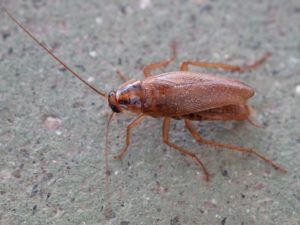 Bug bombs don't work in reducing cockroach infestations. At all. A study comparing bug bombs vs gel baits found that while big bombs didn't reduce German cockroach numbers, the baits did. And on top of that, even when used correctly (according to directions) the bug bombs resulted in a lot of pesticide residue throughout the residences - at 6 hours after being used, and one month later. The technical name for bug bombs is total release foggers. Different brands of bug bombs, with different pesticides, were used in the study - two different kinds of Hot-Shot No-Mess Foggers and two different kinds of Raid foggers. The gel baits used were Combat Insect Control Systems and Maxforce Gel Bait.
Bug bombs don't work in reducing cockroach infestations. At all. A study comparing bug bombs vs gel baits found that while big bombs didn't reduce German cockroach numbers, the baits did. And on top of that, even when used correctly (according to directions) the bug bombs resulted in a lot of pesticide residue throughout the residences - at 6 hours after being used, and one month later. The technical name for bug bombs is total release foggers. Different brands of bug bombs, with different pesticides, were used in the study - two different kinds of Hot-Shot No-Mess Foggers and two different kinds of Raid foggers. The gel baits used were Combat Insect Control Systems and Maxforce Gel Bait.
The North Carolina State Univ. researchers pointed out that one major problem with bug bombs is that cockroaches have built up resistance to the pesticides used. Another problem is that their use in residences results in pesticide residues, even one month later. That means that people living there will breathe in or ingest the pesticide residues. Which can lead to health problems.
On the other hand, there was no pesticide residue from the baits in the residences. And they reduced numbers of cockroaches. Using baits for cockroach control is a wonderful example of Integrated Pest Management - a least-toxic way of dealing with pests using various methods (e.g. baits, traps, fixing holes, vacuuming pests). Even though they were not used in the study, one should also consider bait gels containing boric acid.
From Beyond Pesticides: Bug Bombs Don't Work - At All, According to Study
Bug bombs are completely ineffective at reducing German cockroach infestations, according to new research published in the journal BMC Public Health. Not only are they ineffective, research indicates that these products are putting people at unnecessary risk. “In a cost-benefit analysis, you’re getting all costs and no benefits,” said Zachary DeVries, PhD, co-author of the study. “Bug bombs are not killing cockroaches; they’re putting pesticides in places where the cockroaches aren’t; they’re not putting pesticides in places where cockroaches are and they’re increasing pesticide levels in the home.”
Scientists enrolled residents in 30 low-income apartments that had ongoing German cockroach infestations. Of the 30 homes, 20 were treated with a name-brand total release fogger (TRF), or bug bomb, and and 10 were treated only with gel baits. Baseline pesticide residue levels were recorded in all residences, and new data was collected after use of the bug bombs.
Bug bombs were set off in each infested apartment’s kitchen, according to EPA label precautions. Residents waited 4-6 hours before ventilating and returning to their homes. In apartments receiving baiting gel treatments, the products were applied three times on an as-needed basis during the course of a month. Traps were used to gauge baseline cockroach levels and the population response from the treatments.
“All the fogger products contained pyrethroids, a class of fast-acting insecticides, and some contained piperonyl butoxide, a chemical that prevents roaches from metabolizing, or breaking down, the insecticide,” said Coby Schal, PhD, Blanton J. Whitmire Distinguished Professor of Entomology at NC State and co-author of the paper.
While these products are marketed as effective against German cockroaches, researchers did not find that to be the case. The study indicates there was no significant difference between cockroach population levels before and after the use of any name brand bug bomb. “The bug-bomb products did absolutely nothing to control cockroach populations in these homes,” Dr. DeVries said.
Not only did these products not work, but surface tests showed that resident kitchens increased their pesticide levels 600x over baseline results. “Baseline levels of insecticides in these homes makes sense, because residents with moderate to severe cockroach infestations are likely to use insecticides to attempt to eliminate roaches,” Dr. DeVries noted. “However, what was most disconcerting was that these swabs were collected from the middle of floors and kitchen surfaces, locations where roaches don’t generally congregate.”
Tests conducted one month after the bug bombs were released still showed pesticide residue levels 34% higher levels originally found in resident’s homes. This is unsurprising, as research finds that once applied, synthetic pyrethroids can persist in the home for over a year, putting individuals and families at risk of chronic exposure and subsequent health issues.
The U.S. Environmental Protection Agency made minor changes to the labels of bug bomb products in 2008 due to widespread reports of poisoning. Over 450 people had become sick after using a fogger between the years 2001-2005, and a 10 month old boy in Williamston, SC died after his mother used several bug bombs in their home. However, recent data shows EPA’s changes to be ineffective at even slightly reducing harm. Between the years 2007-2015 the U.S. Centers for Disease Control and Prevention indicates that 3,222 unique cases of illness and injury were reported from the use of bug bombs.
 German cockroach Credit: Wikipedia
German cockroach Credit: Wikipedia
